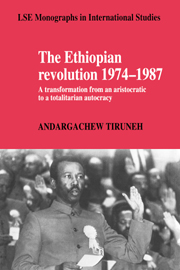 The Ethiopian Revolution 1974–1987
The Ethiopian Revolution 1974–1987 Book contents
- Frontmatter
- Contents
- List of maps and tables
- Acknowledgements
- List of abbreviations
- Map 1 The Horn of Africa
- Map 2 Administrative divisions
- 1 The background to the emergence of the structural crisis
- PART I THE COLLAPSE OF THE OLD-STATE (JANUARY–NOVEMBER 1974)
- 2 The urban uprising of January to June 1974
- 3 The turning of an urban movement into a junta dictatorship
- PART II THE FORMATIVE YEARS OF THE POST-REVOLUTIONARY ORDER (DECEMBER 1974–FEBRUARY 1977)
- PART III CONSOLIDATION OF POWER (FEBRUARY 1977–SEPTEMBER 1987)
- Postscript
- Appendix: chronology of events
- Notes
- Bibliography
- Index
- LSE MONOGRAPHS IN INTERNATIONAL STUDIES
2 - The urban uprising of January to June 1974
Published online by Cambridge University Press: 18 December 2009
- Frontmatter
- Contents
- List of maps and tables
- Acknowledgements
- List of abbreviations
- Map 1 The Horn of Africa
- Map 2 Administrative divisions
- 1 The background to the emergence of the structural crisis
- PART I THE COLLAPSE OF THE OLD-STATE (JANUARY–NOVEMBER 1974)
- 2 The urban uprising of January to June 1974
- 3 The turning of an urban movement into a junta dictatorship
- PART II THE FORMATIVE YEARS OF THE POST-REVOLUTIONARY ORDER (DECEMBER 1974–FEBRUARY 1977)
- PART III CONSOLIDATION OF POWER (FEBRUARY 1977–SEPTEMBER 1987)
- Postscript
- Appendix: chronology of events
- Notes
- Bibliography
- Index
- LSE MONOGRAPHS IN INTERNATIONAL STUDIES
Summary
The main actors of the popular uprising that erupted from January to June 1974, against Haile Selassie's government, were the armed forces, the teachers, the students, the trade unions and the civil servants. The armed forces, without whose collaboration the other groups would have found it difficult to put up resistance against the government, were composed of five divisions consisting of tens of brigades and battalions dotted all over the country. Bodyguard was situated in the capital, Addis Ababa, as was the Fourth Division, which had brigades and battalions in the provinces. The Second Division, also known as the Northern Forces, and the Third Division were based in Eritrea and Hararghe provinces respectively. The Fifth Division was an amalgam of various specialized units mainly located in and around Addis Ababa.
On 12 January 1974, the privates and NCOs of the 24th brigade (Fourth Division) situated in the town of Negele (Sidamo province) mutinied and placed their officers under arrest. They then demanded to see senior government officials who would meet their demands, which included pay and pension increases, better food allowances, injury benefits, improved living quarters, removal of disciplinary injustices, price control and access to water wells. When General Derese Dubale, commander of the ground forces, was sent to Negele, the mutineers placed him under arrest, apparently because they wanted to see a higher official than him. They released him after a week only because they were flattered to receive a letter from the King sent through General Assefa Abera, Commander of the air force, promising them that their demands would be met.
- Type
- Chapter
- Information
- The Ethiopian Revolution 1974–1987A Transformation from an Aristocratic to a Totalitarian Autocracy, pp. 37 - 59Publisher: Cambridge University PressPrint publication year: 1993


